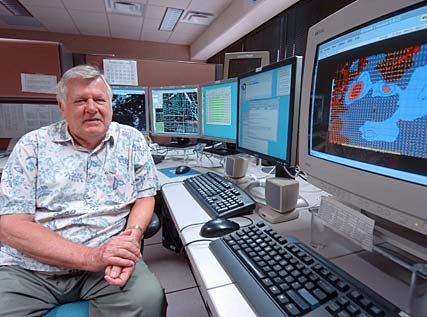Lead forecaster and hurricane program leader with the National Weather Service's Honolulu Forecast Office

|
Changing seasons
Lead weather forecaster
Hans Rosendal retires after
27 years at the Honolulu
Forecast Office
Seventy-three-year-old Hans Rosendal, esteemed by his colleagues as an "icon" and a "legend," is retiring this month after 47 years with the National Weather Service.
Farewell lunch
A lunch honoring Hans Rosendal will be held 11:30 a.m. tomorrow at the Waioli Tea Room, 2950 Manoa Road. Call Pamela Fujiwara for details, 973-5270, or e-mail Pamela.Fujiwara@noaa.gov.
|
But his forecasting skills still will be in demand at his Kailua home. "My wife asks me, 'Is it safe to wash today and hang out clothes?'" Rosendal said with a laugh.
He plans to "dabble a little bit," continuing research and finishing some papers. He's been trying to link four properties of fluid dynamics to weather, and he's studying large-scale atmospheric changes.
Jim Weyman, meteorologist-in-charge of the Honolulu Forecast Office, where Rosendal has worked for 27 years, said: "The greatest thing is he loves what he does. He loves all aspects of weather. ... This isn't just his job, it's his true love."
Over the years, he has worked on floods, thunderstorms, snowstorms on Big Island summits, big surf and hurricanes. He said he "had the pleasure to put out the first hurricane watch" for Iwa in November 1982 and Iniki in September 1992.
"He never seems rushed," Weyman said. "He is always calm and collected, no matter what the situation is."
Bob Farrell, also a lead forecaster, who has known Rosendal 25 years, said: "He is one of our more theoretical forecasters, using equations extensively in his career ... and he's a fine forecaster. He has developed several theories.
"It will be hard to lose that wisdom and knowledge. It takes time to get that weather information in the islands. ... He's well respected in this office, I'll tell you that," Farrell said.
Rosendal's slight accent comes from his background in Denmark, where he was born and lived until moving to the United States in 1951 to stay with an aunt and uncle in Milwaukee. He served in military intelligence in the Army for two years, mostly in Tokyo, where he said most of his co-workers were second-generation Japanese Americans from Hawaii.
Rosendal, who speaks Danish, Swedish, Norwegian, German and a little French and Russian, served as an interpreter with the Swedish and Swiss Neutral Nations Supervisory Commission teams policing the armistice in the Korean War. After his discharge from the Army, he pursued a Bachelor of Science degree in meteorology at the University of Wisconsin.
"'I always liked weather," he said. "I had a favorite TV weatherman in Milwaukee. That kind of got me into it."
In 1960, after getting his bachelor's degree, he worked in the marine section of the Office of Climatology in Washington, D.C., and edited the Mariners Weather Log. He also took oceanography and statistics classes. He earned a master's degree in meteorology at the University of Michigan, then served as Wisconsin's state climatologist until the program was closed in 1973.
From the climatologist position, Rosendal went into forecasting in Milwaukee, then in Phoenix.
In 1978 he got a position in the Honolulu weather office. "I had always been interested in oceanography, waves, surface, temperature, salinity and currents and so on, like the El Nino problem," he said.
Using his oceanography studies and knowledge of wave energy and propagation, he developed an equation estimating surf heights at Hawaii beaches about 10 to 15 hours after the height and period of waves are measured at a buoy 200 miles north-northwest of Kauai.
Rosendal has done extensive research and written papers on rainfall climatology, hurricanes, El Nino/Southern Oscillation and other weather events. He was elected as a fellow in the American Meteorological Society and has received many other honors.
"Weather is great entertainment," he said. "We kind of get paid for what we enjoy doing. It's a field where you improve with age, where with a basketball player, that might not be the case."
www.prh.noaa.gov/hnl/
[News] [Business] [Features] [Sports] [Editorial] [Do It Electric!]
[Classified Ads] [Search] [Subscribe] [Info] [Letter to Editor]
[Feedback]
